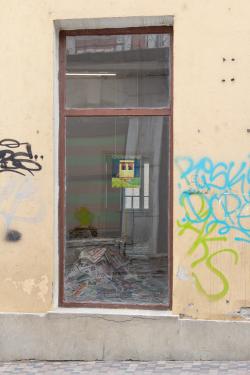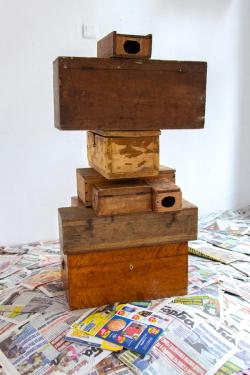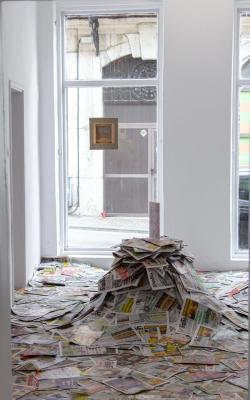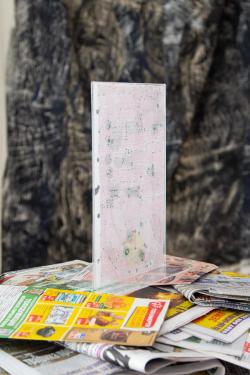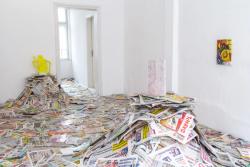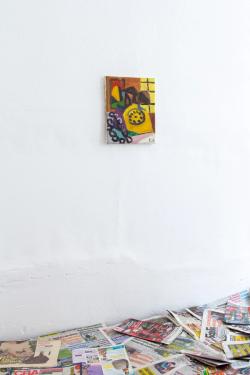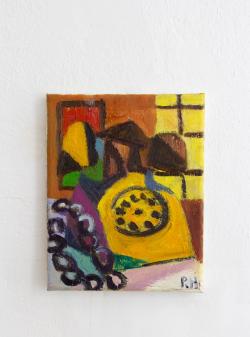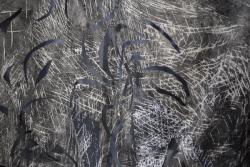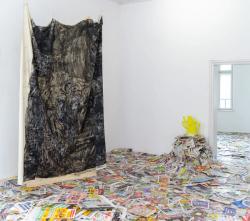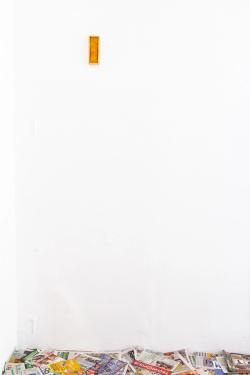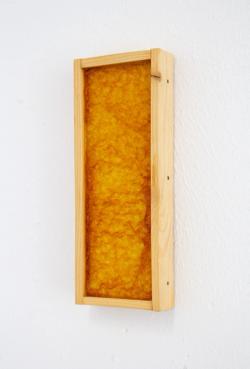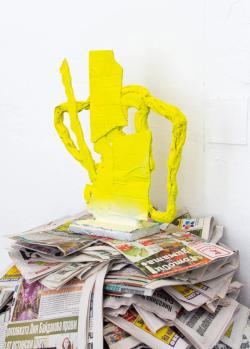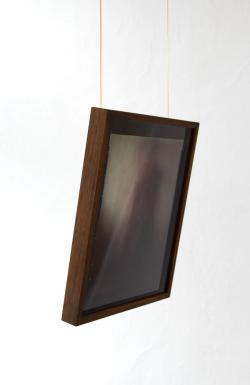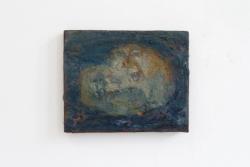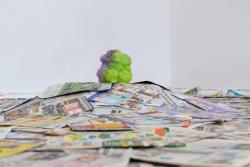Idun Baltzersen, Simon Burton, Paul Housley, Daniel Jensen, Kasper Nordenström Jung, Anders Krisár, Susan Te Kahurangi King, Lisa Lundgren, Anna Ting Möller, Mateas Pares, and Stina Persson
Who Was Branislav Tesanovic?
27.04. – 18.05.2024' /%3E%3C/svg%3E)
Lisa Lundgren Kväll (Evening), 2021 Oil on linen canvas 34 × 31 cm ' /%3E%3C/svg%3E)
Lisa Lundgren Kväll (Evening), 2021 Oil on linen canvas 34 × 31 cm ' /%3E%3C/svg%3E)
Stina Persson Portals, 2021 Wood boxes, nails Varying sizes ' /%3E%3C/svg%3E)
Stina Persson Portals, 2021 Wood boxes, nails Varying sizes ' /%3E%3C/svg%3E)
Who Was Branislav Tesanovic?, 2024 Installation view ' /%3E%3C/svg%3E)
Mateas Pares Hour 442 056 (Bowl), 2024 Polished bronze 24 x 22 x 12 cm ' /%3E%3C/svg%3E)
Mateas Pares Hour 442 056 (Bowl), 2024 Polished bronze 24 x 22 x 12 cm ' /%3E%3C/svg%3E)
Who Was Branislav Tesanovic?, 2024 Installation view ' /%3E%3C/svg%3E)
Susan Te Kahurangi King Untitled, 2012 Graphite and marker on found paper 29.8 x 20.8 cm, double sided ' /%3E%3C/svg%3E)
Susan Te Kahurangi King Untitled, 2012 Graphite and marker on found paper 29.8 x 20.8 cm, double sided ' /%3E%3C/svg%3E)
Who Was Branislav Tesanovic?, 2024 Installation view ' /%3E%3C/svg%3E)
Paul Housley The Telephone, 2023 – 2024 Oil on canvas 30x24 cm ' /%3E%3C/svg%3E)
Paul Housley The Telephone, 2023 – 2024 Oil on canvas 30x24 cm ' /%3E%3C/svg%3E)
Idun Baltzersen Fragmentert Utsikt Over By (Fragmented View Of A City), 2019 Woodcut on fabric, collage 240 x 160 cm ' /%3E%3C/svg%3E)
Idun Baltzersen Fragmentert Utsikt Over By (Fragmented View Of A City), 2019 (Detail) Woodcut on fabric, collage 240 x 160 cm ' /%3E%3C/svg%3E)
Who Was Branislav Tesanovic?, 2024 Installation view ' /%3E%3C/svg%3E)
Kasper Nordenström Jung Transparent 10, 2019 Stretcher frame, panel, linseed oil, cotton canvas 7,3 x 19 cm ' /%3E%3C/svg%3E)
Kasper Nordenström Jung Transparent 10, 2019 Stretcher frame, panel, linseed oil, cotton canvas 7,3 x 19 cm ' /%3E%3C/svg%3E)
Daniel Jensen Calamari, 2024 Aluminium and spray paint 39 x 35 x 12 cm ' /%3E%3C/svg%3E)
Who Was Branislav Tesanovic?, 2024 Installation view ' /%3E%3C/svg%3E)
Anders Krisar Mist Mother Studies, 2006 (printed 2013) Set of five framed chromogenic contact prints each 29,5 x 23,5 cm ' /%3E%3C/svg%3E)
Anders Krisar Mist Mother Studies, 2006 (printed 2013) Set of five framed chromogenic contact prints each 29,5 x 23,5 cm ' /%3E%3C/svg%3E)
Simon Burton Monad Head (Domingo), 2021 Oil and studio waste on canvas on panel 30 × 37.5 × 2.5 cm ' /%3E%3C/svg%3E)
Who Was Branislav Tesanovic?, 2024 Installation view ' /%3E%3C/svg%3E)
Anna Ting Möller Navel Knot, 2023 Glass (hand blown into lost cast) 25 x 25 x 35 cm ' /%3E%3C/svg%3E)
Anna Ting Möller Navel Knot, 2023 Glass (hand blown into lost cast) 25 x 25 x 35 cm
Branislav Tesanovic is 78 years old when he falls to the floor in a corner of his Stockholm apartment and dies face down. There are strong indications that it may have happened Thursday, 10 March, 2016, the day after his birthday, as the note in the calendar on the wall, marking the date 11 March, has not been torn off. Unattended mail has created a large pile on the floor, and the radio is still on, when he is found by the police three years, eight months, and eight days later.
Branislav quickly gets the name ”Stockholm’s Loneliest Man” in media. A documentary is made. Articles are written. Who was Branislav Tesanovic? A few answers are found through the attention of his fate: he came to Sweden from Yugoslavia 40 years ago; he lived in numerous cities in Sweden until he settled in Stockholm; throughout the years he worked as a turner, wood worker, metal worker, filer, and driller; he liked playing outdoor chess; and he was a regular at the restaurant Verona. But who Branislav was underneath his role as a colleague, chess antagonist, and restaurant guest; and what made him go through life for 78 years without having anyone noticing his death until nearly four years later, no one will ever know.
Branislav’s fate is not unique. According to the social services department and the police, similar cases are handled everyday. The exhibition is not about these people’s deaths but about their lives. In that regard the exhibition might as well be about all of us.
Idun Baltzersen was born in 1987 in Trondheim, Norway, and now lives in Stockholm. She has studied at the Kunsthøg- skolen in Bergen and finished her studies with an MFA at Konstfack, University of Arts, Crafts and Design in 2014. Baltzersen’s work is characterized by an experimental approach to graphics and the possibilities of print technologies, manifesting as woodcuts and assemblages of paper, fabric, and wood. The repetitive function of graphics, which makes possible the production of many editions of the same image, is used as a way to explore identities and contemporary myths. The perspective of the girl and the young woman are often in focus. In Baltzersen’s work characters are depicted with their faces turned away or their backs turned to the viewer. The subjects contain a number of details and markers that can be traced to contemporary youth culture. Through monumental depictions and shifting positions, Baltzersen lets the observed occupy space in relation to their observer, thus giving the motifs authority. Baltzersen’s work has been exhibited in numerous exhibitions, including Magasin III Museum for Contemporary Art, Stockholm (2021); Teckningsmuseet, Laholm (2018); Uppsala Konstmuseum (2018, 2017, 2014); Konstakademien, Stockholm (2017) and Moderna Museet Malmö (2015).
Simon Burton lives and works in London. He studied at the University of Brighton (1992–95) and attained a Master's in Painting at The Royal College of Art (1995-97). Burton’s paintings are often figurative, yet subjects only ever exist in a state of fragility. It is this fragility that is the subject itself. His work has been shaped by linking his interrogation of the canon of art history to his interest in the fugacity and fading of memory. Images in his paintings only ever exist in a state of uncertainty. The act of both creating and viewing paintings is like a search for something close to meaning, hard to fix, but the mercurial nature of meaning is present everywhere. This suggests the possibility of interpretation and decoding, which provides hope, but the material choices in the paintings enhance and pronounce the fragility of proposed subjects, leading the subject towards a territory of uncertainty, doubt, and time. His paintings are moments from this ongoing odyssey. Burton' has had ten solo shows to date, including international exhibitions in Germany, South Korea, and America. His work has been shown in numerous exhibitions, recently including ‘Ways of seeing’ Jari Lager Gallery, Köln (2023), ‘PӨƧ Ө ΣM’ OHSH projects, London (2022), ‘A play of features’ Union Gallery, London (2022), ‘Made in Britain’ Muzeum Narodowe w Gdańsk, Poland (2019) and ‘British Contemporary Yantai Art Museum, China (2019). Burton has work in various collections including Abbot Hall Collection, Aldrich Collection, Dimensional Media Associates Collection, USA, Falmouth Museum and Art Gallery Collection, Huddersfield Museum and Art Gallery, Rod and Jenny Hall Collection, Jiangsu Museum of Art, China, William Louis-Dreyfus Foundation, USA, National Irish Visual Arts Library, Priseman-Seabrook Collection, PWC Collection, Robert and Susan Kasen Summer Collection, USA, Royal College of Art Collection, Rugby Museum and Art Gallery, Swindon Museum and Art Gallery, Tianjin Academy of Fine Art, China, University of Essex, Yale Center for British Art, USA, Yantai Art Museum, and China.
Paul Housley graduated with a BA in Fine Art at Sheffield City Polytechnic in 1986 and an MA in Painting from the Royal College of Art in 1995. Deep in the formalities of oil paint, Paul’s work refracts his world and those phenomena that catch his eye. Reaped from the flow of our modernity, the social lives, histories, and restive objet de désir pictured in Paul’s paintings recall those kaleidoscopic moments captured by the poetic M.G., Baudelaire’s modernist legend.
Daniel Jensen’s sculptures, paintings, and drawings explore issues related to fractal urban structure and detritus, which witness our existence. His broader artistic practice is allied with subjects like imperfection, failure, and transformation. The artist’s ” object trouvé” alternate between the recognizable and the abstract, where under esteemed perishable materials are assembled in poised and fragile compositions, after which they are cast in solid aluminum and spray painted. These works have a poetic and liberating non-hierarchal expression without the concept of any specific narrative, which constitutes changes in our perception of utility, lifespan, and status. His sculptures are entwined and unconstrained, placing the viewer in an odd state of amusement, wonder, and contemplation. He has been exhibited extensively both in Sweden as well as internationally i.e. Björkholmen Gallery, Stockholm (SE), Alzueta Gallery, Barcelona/Madrid (ES), Monti8, Latina, (IT), Kant, Copenhagen (DK), The Dot Project, London (GB), Fifi Projects, Mexico City (MX), L21 Gallery, Palma de Mallorca (ES), Richard Heller Gallery, Los Angeles (US), Ronneby Konsthall, Ronneby (SE), Peter Bergman, Stockholm (SE). Jensen is represented in collections such as Malmö Art Museum (SE), The National Public Art Council of Sweden, Region Stockholm (SE), Investor AB (SE), Akzo Nobel Art Foundation, Amsterdam (NL), Steve Shane Collection, New York (US).
“My working hypotheses has been that through addressing painting sculpturally, I can shape bodily emotions and movements as expressions of psychological processes. I have therefore focused on materials that I have used when painting, and avoided hue to reinforce a sense of honesty towards this material. The fact that I abstain from color and hue does not mean that I dismiss them as means of expression or their capacity to express what I intend. It is merely a conscious choice to assume a stringent position vis-á-vis the physical material. In addition, I acknowledge that materials qua matter unavoidably have hues which in themselves are expressive. In my work process, I relate to painting as a mode of expression. Stretcher bar, canvas, panel, and linseed oil. Even sculptur- al materials as Jesmonite. The materials have been afforded the space to realize their inherent natures within theframework I have defined. The process, too, has been afforded the time it needs with linseed oil as the controlling or dominating agent. Emotions with friction have occupied most of my work. One reflection is that this it the type of emotion that propels emotional and personal development. Yet at once, it has become clear that it is no simple task to portray what we normally call positive feelings in a serious way. Which could be understood as an inherent conflict. Criticism and negativity are more often perceived as initiated. A strictly problematizing approach is neither necessarily sustainable nor desirable in the long run.” - Kasper Nordenström Jung
Largely an autodidact, Anders Krisár decided to become a visual artist only in his late twenties. Krisár’s output — primarily in sculpture and photography—may be seen as hermetic or even morbid, playing as it does with casting, molds, and deformation. Yet the artist’s skillful and poetic deployment of a deeply felt intuition has given rise to a body of work that reveals the physical, experiential, and societal yearnings and limitations of man, making it altogether human. The autobiographical quality of Krisár’s practice and his focus on familial concerns connects him to artists working in the same lineage, such as Surrealist and feminist sculptor Louise Bourgeois. Krisár’s opus also evokes the worlds created by Robert Gober by way of his themes of domesticity, nature, and eroticism; Kiki Smith, through her ideas on birth and regeneration; Ron Mueck, in his usage of hyperrealism and casting; and Richard Dupont, via his use of technologies involving replicas and body scanning. Yet what defines Krisár’s particular worldview is his keen sense of aesthetics, which manages to balance his need to investigate deep-rooted traumas with stringent conceptualism.
Susan Te Kahurangi King (born 1951), a self-taught artist from New Zealand, has been creating extraordinary drawings prolifically and skilfully since her childhood. Having lost her speech around the age of five, and unable to read or write, King expresses her thoughts, feelings, understandings, observations, fears and fascinations through her incredible drawings. Since 2009, King has exhibited in galleries and museums across the globe. Her works are in many international Collections, both public and private, including The Philadelphia Museum of Art, the Museum Of Modern Art (MoMA) New York, the Auckland Art Gallery, and the Collection of KAWS. Susan lives in New Zealand and continues her practice as a contemporary artist, relishing her emersion from half a century of producing work in obscurity.
Lisa Lundgren's paintings are at once direct and enigmatic. The motif's dreamy narrative is presented through the artist's very distinguishable expression. The saturated color scale on the coarse linen canvas enhances a sense of tactility and adds an extra dimension to the work. The viewer is invited to a hidden scenery through a passage. Lundgrens works are characterized by a visual intimacy that defies interpretation, inspiring the spectator to serenity and contemplation. Lisa Lundgren graduated from the Royal Institute of Art in Stockholm in 2019. Since then, she has been shown at Björkholmen Gallery, Kristinehamn Art Museum, Galleri Bo Bjerggaard in Copenhagen, and in the Stockholm metro. Lisa's art is represented by Region Västra Götaland and Region Uppsala.
Anna Ting Möller is an artist living and working in New York City and Stockholm. Möller received an MFA from Columbia University, New York, and a BFA from Konstfack University, Stockholm, SE. The artist has a forthcoming solo exhibition, which will be held at Galleri Dueer, SE. Möller’s work has been exhibited around the world including Liljevalchs, SE; ArkDes, SE; Carl Eldh, SE; ICPNA La Molina, PE; Luan Gallery, CH; Titanik, FI, Gallery Tutu, US; Island Gallery, US; Urban Glass, US; and Alexander Berggruen, US. They participated in the 45th Tendencies Biennale in Norway. The artist's work has been reviewed in Hyperallergic online art magazine, Cultbytes, The Daily News, SE; amongst others.
Despite the eye being drawn to the sculptures, the canvas is very much at the center of Pares' practice. Through the combination of materials in different figurations and details with the canvas, Pares has created his own relationship with the canvas as a sculptor, in which he uses the sculptures as tools to transform the canvas into projection surfaces for various abstract concepts. Thematically, Pares often returns to questions about what it entails to live with the means one was given and our striving to fit in. The result often creates a feeling of the sculptures and the canvas being forced together into a state that seems to have no resolution, oscillating between abstraction and figurative. Pares studied graphic design and commercial arts at Beckmans College of Design and Bergh’s in Stockholm and has been awarded the Cannes Grand Prix, Epica d’Or, and other notable awards for his work. Since 2012 Pares works fulltime with his art and since 2020 he also runs and curates the exhibition project StudyForArtPlatform in Stock- holm. Pares’ works have been featured at Gallery Golsa (NO), Gallery Steinsland Berliner (SWE), and National Gallery (BiH), among others, and can be seen in private collections around the world.
Stina Persson’s sensible sculptures grow into three-dimensionality from images in her mind. By working from within the clay, she undertakes a journey in her own mind and thoughts, carefully and slowly releasing the figure inside the material. Her method is that of releasing and creating simultaneously. The connection of mind to hand is vital, and her works ask questions about the sculpture’s state of being. Her forms dwell in the middle grounds of figuration and abstraction, dealing with the most ancient of questions regarding creation itself. Her sculptures also show the passing of time, marks from her hand and from their process of growing, are often visible in her large as well as smaller works.
StudyForArtPlatform is an explorative exhibition project founded in 2020 by artist and curator Mateas Pares. Housed in a highly condensed white cube space in the heart of the creative district in central Stockholm, StudyForArtPlatform aims to offer Swedish and international artists an alternative opportunity to examine their artistries through large exhibitions in a small format.
office@studyforartplatform.com
The exhibition is supported by Tequila Bar Fnky Mnky. And many thanks to EcoPartners in Veliko Turnovo.
